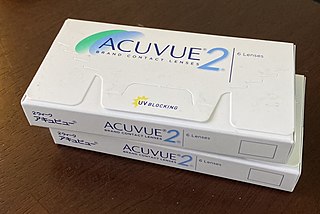
Polyvinylpyrrolidone (PVP), also commonly called polyvidone or povidone, is a water-soluble polymer compound made from the monomer N-vinylpyrrolidone. PVP is available in a range of molecular weights and related viscosities, and can be selected according to the desired application properties.

Bausch & Lomb is an American-Canadian eye health products company based in Vaughan, Ontario, Canada. It is one of the world's largest suppliers of contact lenses, lens care products, pharmaceuticals, intraocular lenses, and other eye surgery products. The company was founded in Rochester, New York, in 1853 by optician John Bausch and cabinet maker turned financial backer Henry Lomb. Until its sale in 2013, Bausch + Lomb was one of the oldest continually operating companies in the United States.

Contact lenses, or simply contacts, are thin lenses placed directly on the surface of the eyes. Contact lenses are ocular prosthetic devices used by over 150 million people worldwide, and they can be worn to correct vision or for cosmetic or therapeutic reasons. In 2010, the worldwide market for contact lenses was estimated at $6.1 billion, while the US soft lens market was estimated at $2.1 billion. Multiple analysts estimated that the global market for contact lenses would reach $11.7 billion by 2015. As of 2010, the average age of contact lens wearers globally was 31 years old, and two-thirds of wearers were female.

An Intraocular lens (IOL) is a lens implanted in the eye usually as part of a treatment for cataracts or for correcting other vision problems such as short sightedness and long sightedness; a form of refractive surgery. If the natural lens is left in the eye, the IOL is known as phakic, otherwise it is a pseudophakic lens. Both kinds of IOLs are designed to provide the same light-focusing function as the natural crystalline lens. This can be an alternative to LASIK, but LASIK is not an alternative to an IOL for treatment of cataracts.

Orthokeratology, also referred to as Night lenses, Ortho-K, OK, Overnight Vision Correction, Corneal Refractive Therapy (CRT), Accelerated Orthokeretology, Cornea Corrective Contacts, Eccentricity Zero Molding, and Gentle Vision Shaping System (GVSS), is the use of gas-permeable contact lenses that temporarily reshape the cornea to reduce refractive errors such as myopia, hyperopia, and astigmatism.

Acuvue is a brand of disposable contact lenses made in Jacksonville Florida and Limerick-based Vistakon, a subsidiary of Johnson & Johnson (J&J).
ReNu is a brand of soft contact lens care products produced by Bausch & Lomb. By far the most popular brand of lens solutions until 2006, ReNu has rebranded its formulations as renu sensitive and renu fresh, the latter containing a patented ingredient called hydranate, known by chemists as hydroxyalkylphosphonate, that removes protein deposits and can eliminate the need for a separate enzymatic cleaner.

Emedastine (trade name Emadine) is a second generation antihistamine used in eye drops to alleviate the symptoms of allergic conjunctivitis. It acts as a H1 receptor antagonist. It works by blocking the action of histamine that causes allergic symptoms. It is used in form of the difumarate. The emedastine difumarate is a white, crystalline, water-soluble fine powder. Emedastine eye drops is usually applied twice a day to the affected eye. When the patients with allergic conjunctivitis were treated with 0.05% emedastine difumarate ophthalmic solution for six weeks, the signs and symptoms such as redness, itching and swelling of the eyes were relieved. Emedastine appears to be devoid of effects on adrenergic, dopaminergic and serotonin receptors. This drug was developed by Alcon, which is global medical company specializing in eye care products.
Fungal keratitis is a fungal infection of the cornea, which can lead to blindness. It generally presents with a red, painful eye and blurred vision. There is also increased sensitivity to light, and excessive tears or discharge.
Oxygen permeability (OP) is a parameter of a contact lens that expresses the ability of the lens to let oxygen reach the eye by diffusion. In soft contact lenses, it is dependent on the thickness of the lens and the material of the lens, especially concerning the water content. Because of this dependence on thickness, transmissibility level, the Dk per thickness of the lens, is more commonly used.

Bepotastine is a 2nd generation antihistamine. It was approved in Japan for use in the treatment of allergic rhinitis and urticaria/pruritus in July 2000, and January 2002, respectively. It is marketed in the United States as an eye drop under the brand name Bepreve, by ISTA Pharmaceuticals, a subsidiary of Bausch + Lomb.

Besifloxacin (INN/USAN) is a fourth-generation fluoroquinolone antibiotic. The marketed compound is besifloxacin hydrochloride. It was developed by SSP Co. Ltd., Japan, and designated SS734. SSP licensed U.S. and European rights to SS734 for ophthalmic use to InSite Vision Incorporated in 2000. InSite Vision developed an eye drop formulation (ISV-403) and conducted preliminary clinical trials before selling the product and all rights to Bausch & Lomb in 2003.
KeraSoft is a patented range of soft and silicone hydrogel contact lenses designed to manage the condition of irregular corneas including keratoconus. They are marketed as an alternative to rigid gas-permeable lenses, offering improved comfort and longer wearing times.

Alimera Sciences, Inc. is a biopharmaceutical sales company based in Alpharetta, Georgia that specializes in the commercialization and sales of prescription ophthalmic pharmaceuticals. The company's main selling focus is on diseases affecting the back of the eye, or retina. The company is the licensee for Iluvien, a fluocinolone acetonide intravitreal implant.
Google Contact Lens was a smart contact lens project announced by Google on 16 January 2014. The project aimed to assist people with diabetes by constantly measuring the glucose levels in their tears. The project was being carried out by Verily and as of 2014 was being tested using prototypes. On November 16, 2018, Verily announced it had discontinued the project.

Lifitegrast, sold under the brand name Xiidra, is a medication for the treatment of signs and symptoms of dry eye, a syndrome called keratoconjunctivitis sicca. Lifitegrast reduces inflammation by inhibiting inflammatory cell binding. It is often used in conjunction with ciclosporin for dry eye treatment including meibomian gland dysfunction and inflammatory dry eye.

Dean Evan Hart, O.D., M.A., M.S., B.S., A.A.S., F.A.A.O. is an American scientist, clinical optometrist, professor, and the founder of Woodbury Ophthalmic Group and Woodbury Optical Studio. Dean ran for Nassau County Legislature in 2015. He was a candidate for the New York State Assembly in the 15th Assembly District of the 2016 election. Hart also ran for town office in 2017.

Irvin M. Borish was an American optometrist who is widely considered "The Father of Modern Optometry". Even though he entered the field of optometry because his family could only afford to pay for two years of college, he left a lasting impression in the field. He wrote one of the most renowned textbooks of optometry, Clinical Refraction. He worked to create several educational and research institutions for optometry. He also lobbied tirelessly to establish optometry as a mainstream medical practice. His contribution to optometry has been recognized through prestigious awards and recognition from his peers.

Ophthalmic drug administration is the administration of a drug to the eyes, most typically as an eye drop formulation. Topical formulations are used to combat a multitude of diseased states of the eye. These states may include bacterial infections, eye injury, glaucoma, and dry eye. However, there are many challenges associated with topical delivery of drugs to the cornea of the eye.
Visibly, formerly known as Opternative, is a telehealth Chicago-based company which provides on-line vision tests and generates eyeglasses and contact lens prescriptions.













